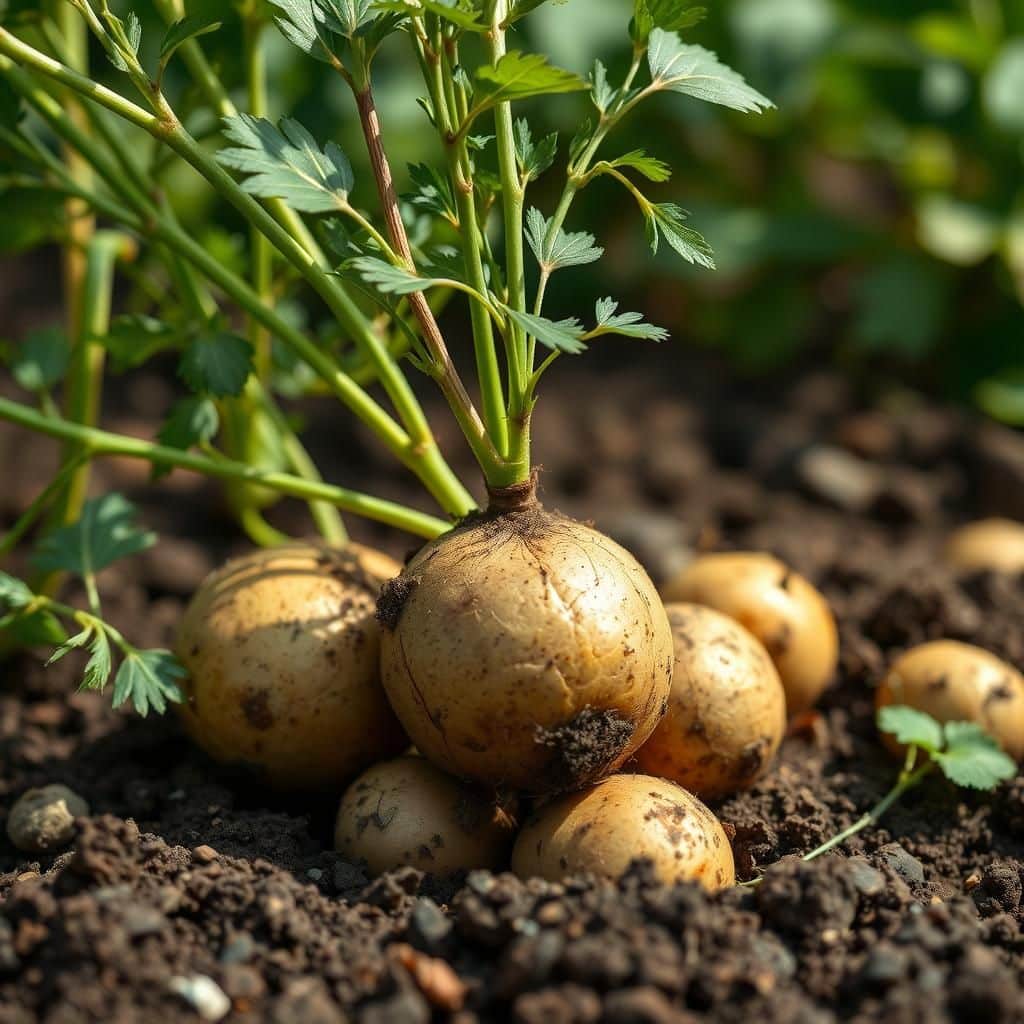Ultimate Guide: How to Plant Potatoes from Eyes for a Bountiful Harvest

Growing potatoes from eyes is a rewarding endeavor that promises a bountiful harvest with careful planning and execution. This ultimate guide is designed to provide you with all the essential information needed to successfully plant and cultivate potatoes. From selecting the right seed potatoes to understanding the best planting techniques and care practices, each step is crucial for ensuring a thriving crop. Whether you're a seasoned gardener or a novice, this guide will equip you with the knowledge necessary to enjoy a delicious and plentiful potato yield, transforming your gardening experience into a fruitful and satisfying journey.
How to Successfully Plant Potatoes from Eyes
Planting potatoes from eyes is a simple yet effective method to grow your own fresh potatoes at home. Start by selecting high-quality seed potatoes that have several eyes or sprouts on them. These eyes are small buds from which new potato plants will grow. Before planting, cut the seed potatoes into pieces, ensuring that each piece contains at least one eye. Allow the cut pieces to dry for a day or two to form a protective callus. Finally, plant the potato pieces in well-draining soil, burying them about 4 inches deep, and space them adequately to allow for growth, covering them lightly with soil, and water them regularly to encourage healthy growth.
Selecting the Right Seed Potatoes
When selecting seed potatoes, it's essential to choose certified disease-free potatoes from a garden center or reputable supplier. Look for firm potatoes with multiple eyes, as these are more likely to produce healthy plants. Avoid using grocery store potatoes, as they may be treated with chemicals that inhibit sprouting or could carry diseases. For best results, opt for specific varieties that are known for your growing conditions and taste preferences.
Preparing the Seed Potatoes
Before planting, you need to prepare the seed potatoes properly. Begin by washing them to remove any dirt, which can harbor diseases. Once clean, allow them to dry and then cut them into pieces, making sure each piece has at least one strong eye. The pieces should be about the size of a golf ball. After cutting, let the pieces sit for 24 to 48 hours until calloused, which helps prevent rot once they are planted.
Choosing the Right Soil and Location
Potatoes thrive in well-draining, loose soil that allows their roots to spread freely. Choose a location that receives plenty of sunlight—at least 6-8 hours a day is ideal. Test the soil pH; potatoes grow best in slightly acidic soil (pH 5.5 to 6.5). If necessary, amend your soil with organic matter such as compost or well-rotted manure to improve its texture and nutrient content.
Planting Techniques
When planting your potato eyes, ensure that you dig holes approximately 4 inches deep and space them about 12 inches apart in rows. Place the potato pieces with the cut side down and the eyes facing up, covering them lightly with soil. Water the planted areas gently to avoid displacing the soil. Depending on your climate, the ideal planting time is usually in the early spring when the soil has warmed sufficiently.
See also:
Watering and Care After Planting
After planting, it is important to keep the soil consistently moist but not waterlogged. Water the plants regularly, especially during dry spells, and ensure that the surrounding weeds are kept under control. As the plants grow, you may need to hill the soil around the base of the plants to encourage more tuber growth and protect them from sunlight. This technique also helps prevent rot and disease.
| Step | Description |
|---|---|
| Selecting Seed Potatoes | Choose certified, disease-free potatoes with multiple eyes. |
| Preparing Potatoes | Wash, dry, and cut potatoes ensuring each piece has an eye. |
| Soil & Location | Use well-draining, loose soil with adequate sunlight. |
| Planting Techniques | Plant chunks 4 inches deep and 12 inches apart. |
| Watering & Care | Keep soil moist and hill plants as they grow. |
How do you prepare potato eyes for planting?

To prepare potato eyes for planting, follow these steps carefully to ensure successful growth. The process involves selecting the right tubers, cutting them appropriately, and allowing them to heal. Here's a detailed guide on how to properly prepare potato eyes for planting.
Choosing the Right Seed Potatoes
Selecting quality seed potatoes is crucial for a healthy harvest. Look for certified seed potatoes from reputable suppliers to minimize pest and disease risks. Choose tubers that are firm and healthy, avoiding any that show signs of rot or disease.
- Inspect seed potatoes for blemishes or soft spots.
- Choose medium-sized potatoes, as they typically yield better results.
- Ensure that the potatoes are free from any chemicals or pesticides.
Identifying Eye Location
Once you have selected your seed potatoes, the next step is to identify the eyes. Potato eyes are the small buds on the surface of the potato that will develop into shoots.
- Look for undamaged eyes, which appear as small, darkened spots on the potato skin.
- Ensure that each piece has at least 2-3 eyes to support healthy growth.
- Preferably, select eyes that are swollen or slightly green, indicating they are ready to sprout.
Cutting Seed Potatoes
If you're using larger potatoes, you may need to cut them into smaller pieces. This should be done carefully to ensure each piece has healthy eyes and can support sprouting.
See also:
- Use a clean, sharp knife to cut the potato into pieces, ensuring each piece has at least one eye.
- Make sure to cut the potato in a way that does not result in multiple pieces with a single eye, as this can limit growth.
- Leave the cut side as flat as possible to help the potato heal quickly.
Allowing Cuts to Heal
After cutting the potatoes, it's essential to allow the wounds to heal before planting. This helps prevent rot and increases the chances of successful sprouting.
- Place the cut pieces in a cool, dry area for 24-48 hours.
- Keep them out of direct sunlight to avoid excessive moisture loss.
- Ensure the pieces are not stacked on top of each other to allow air circulation.
Preparing for Planting
Once the potato pieces have healed, they are ready for planting. Make sure you choose a suitable location and soil to maximize growth potential.
- Select a sunny location with well-draining soil, rich in organic matter.
- Before planting, prepare the soil by loosening it and incorporating compost for added nutrients.
- Space the potato pieces about 12 inches apart to allow proper growth and tuber development.
Questions from Our Readers
What are potato eyes and why are they important for planting?
Potato eyes are the small buds or germinations found on the surface of a potato. They are important for planting because each eye has the potential to grow into a new potato plant, producing tubers through the process of vegetative reproduction.
How should I prepare potatoes before planting them from eyes?
Before planting, it is essential to cut the potatoes into pieces, ensuring each piece has at least one or two eyes. Allow the cut pieces to cure for a few days in a cool, dry place to form a protective callus, which helps prevent rot and disease once planted.
What is the best time of year to plant potatoes from eyes?
The best time to plant potatoes is in the spring, typically a couple of weeks before the last expected frost. This timing allows the potatoes to grow in optimal conditions, taking advantage of the warmer soil and longer days as summer approaches.
What kind of soil is ideal for planting potatoes from eyes?
Potatoes thrive in loamy, well-drained soil with good fertility. It is important to ensure the soil is rich in organic matter and has a slightly acidic pH level, typically between 5.5 and 6.5, to promote healthy growth and maximize tuber production.
See also:

If you want to read more articles like Ultimate Guide: How to Plant Potatoes from Eyes for a Bountiful Harvest, we recommend you check out our Seeds category.
Leave a Reply
Related Articles